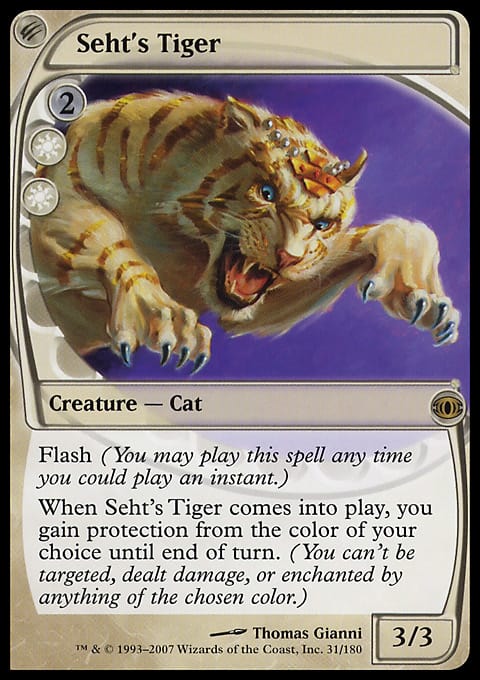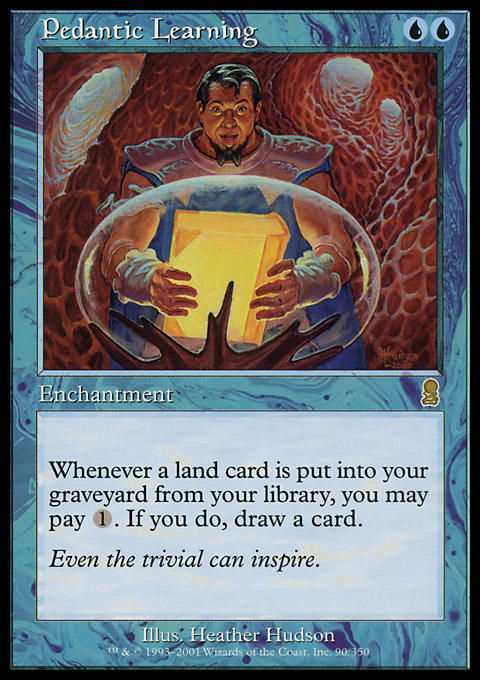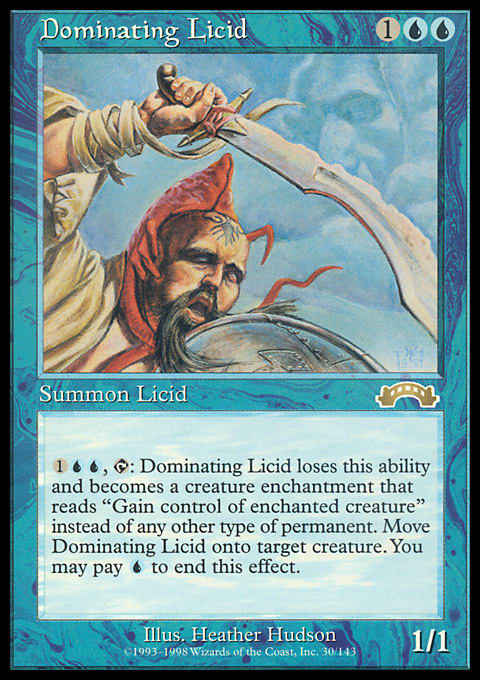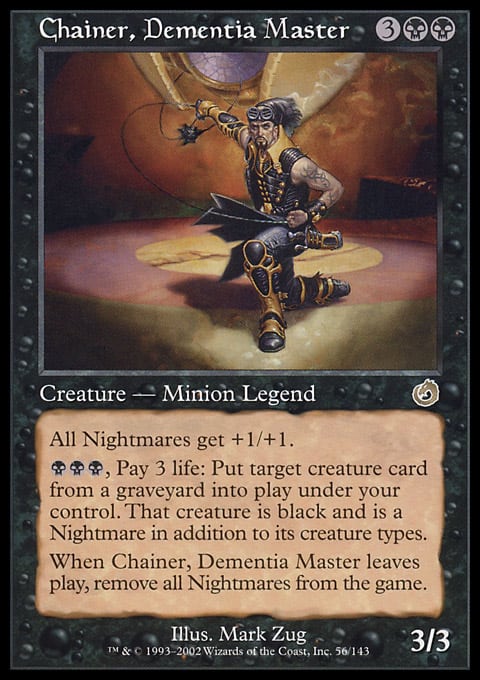In the last sixteen months of unemployment, I’ve really learned that Magic doesn’t have to be expensive. There are a lot of great cards out there that are underplayed and come with cheap price tags.
This series began with an article that featured older, underused, and undervalued cards that would be good to rock in Modern decks. The highlight of that article was Foster, a card I think needs some extra time in the sun. (Which will happen more now that it has an appearance in a Commander (2013 Edition) deck) Another entry followed, and today sees another group of fifteen rares that are cheap and powerful. In these three articles, I have looked at forty-five cards for your use, and each has a very high price-to-power ratio since they cost so little to begin with.
Each of these rares clocks in at under $1 near mint on CoolStuffInc.com as of the writing of this article. So, let’s take a look!
Seht's Tiger – Giving yourself protection from a color has several useful benefits. For one, you can prevent all damage from that color for the turn. That makes the Tiger a pseudo-Fog effect. Just flash it out, and prevent damage from a color. You can also use to keep yourself save from that X-mana burn spell or mass damage such as from an Earthquake or a Hurricane. Protection from a color also keeps you from being targeted, so it acts as a pseudo-Counterspell on any spell or ability that is targeting you. Also, because the Tiger has flash, you can use all of the established flash tricks, such as flashing in a blocker to kill something. That’s a lot of use from an underused card.
Shard Phoenix – This flying creature brings several interesting powers to the table. First, it’s a flying blocker that can be reanimated when it dies to block again and again (or to swing again and again). It can be recurred after a Planar Cleansing or other form of removal. It can be forced through a counter wall—eventually, the control player will run out of counterspells. And let’s not forget that you can sacrifice it to deal 2 damage to creatures. That clears out a lot of utility creatures, from Oracle of Mul Daya to Fog Bank and from Wellwisher to Soul Warden. It can also add some damage in after combat to finish off some damaged bodies. It’s a strong tool to assist in a variety of situations.
Pedantic Learning – Pedantic Learning is one of those cards that you have to see to realize exists. It lurks back in the hidden depths of Magic’s history. Unless you are searching for something very specific on Gatherer, you probably don’t even know what it does, so I am pulling it out. Every dying land creates a death trigger for you, and you can spend a colorless mana to draw a card with it. Since the enchantment is cheap to drop (just a pair of blue mana), you can play it easily and then rack up triggers over time. It works very well in any deck that is sacrificing lands regularly, such as some Life from the Loam/Crucible of Worlds decks or ramp decks (which will sacrifice anything from a fetch land to Strip Mine or Gargoyle Castle). Take a close look at this guy.
Crypt of Agadeem – Although this is a little harder to set up than cards such as Cabal Coffers or even Nykthos, Shrine to Nyx, it is also more reliable. Any deck with a lot of black creatures and a reliable way of stocking the graveyard qualifies. Cards like Buried Alive play quite well with the concept, and it works great with a lot of cards and concepts from the Innistrad world, from reprinted Mulch to Forbidden Alchemy. Your graveyard—and mana base—will thank you.
Collective Unconscious – Have you ever seen a green deck that could reliably have a lot of creatures in play game after game? Perhaps they were tokens or maybe a Priest of Titania/Gaea's Cradle–fueled Elf deck that vomited creatures all over the battlefield. We’ve often seen green decks rock a lot of creatures and then run out of juice. Well, suggest this card to those players. When an Elf player has a board of fun, he or she can just play this sorcery and draw a new hand o’ cards without slowing down.
Dominating Licid – Licids’ mechanics have to be among the most confusing mechanics we’ve ever seen. But we’ve played with them enough over the years to understand how they work. You can block with one and then tap it to turn into an Aura. You can even hop off the creature, block, tap it to become an Aura again, and create a useful barrier that way. The Dominating is truly among the best Licids at this trick. Control one of the opposing creatures, and its controller won’t attack. Then, when you are attacked by a few creatures, spend some mana to hop it off. Block. Then, tap it, and take control of another attacker, thereby removing it from combat. You may have stopped three creatures from attacking you. That’s in addition to using this is a virtual Control Magic that can be pulled off and put on another creature when a bigger comes around—or pulled off and reused right before the controlled creature dies. Trust me; this card has some value for your next blue control deck.
Morningtide – Sure, it exiles your graveyard, too, but a simple 2-mana sorcery that can exile all graveyards is an elegant tool against a lot of multiplayer crap. If your metagame is rife with reanimation, the aforementioned Life from the Loam, flashback, and other tricks, this is one of the right tools for the job. It exiles every graveyard, so all players lose their cool stuff. And since you are playing this in your deck, you can keep your graveyard use/abuse to a minimum.
Void Maw – Speaking of exiling cards, consider Void Maw. It works really well in decks with mass removal (especially when other creatures are those removed, a la cards like Plague Wind or Hellfire). Exile all of the dying creatures with the Void Maw, and then you can keep them exiled or run them back to their controllers’ graveyards for a temporary pump for the Maw. I’ve seen a Maw go lethal multiple times with stocked stacks of exiled cards ready to blow opponents out of the water—doing its best Psychatog impression. The best part is that it stops tricks such as sacrificing creatures and bringing them back with Volrath's Stronghold or even via persist or undying.
Word of Seizing – Threaten effects are fine, and people can really do some damage, but when they are just sorceries, their use is often limited. Instant Threatens can be useful to steal a creature for defensive purposes when needed. This can not only perform all of those roles, but the split second enables you to take something that might otherwise have been contested. Take a creature with a sacrifice ability, such as that Etched Oracle, Magus of the Jar, Spike Weaver, or Triskelion. Ignore any possibility of countermagic or responses. Make sure that you take what you want and smash opponents with it.
Holistic Wisdom – This classic engine is another undervalued card at the multiplayer table. Take a look: Spend 2 mana and exile a card from your hand. Seems rough, right? But then, you return any card with a shared type from your graveyard to your hand for another use. I’ve seen this broken with anything from Time Warp effects to mass card-draw to burn to trading a cheap creature for that big beater later in the game. It’s flexible, and it can be the engine for a lot of different decks.
Mind Shatter – This is a potent card that never really saw the respect it deserved. It’s just 1 more mana than Mind Twist, one of the most frustrating and powerful sorceries ever printed. Imagine if they printed Balance at 3 mana—still broken, right? Mind Shatter with two black and X is still really nasty and can strip a lot of cards (at random) from someone’s hand. In casual play, you often have the extra turn for mana anyway, and in multiplayer, someone always seems to be keeping back a grip of cards. A lot of players will hold back a handful of cards and let their foes go at it and sit back, with ammo still loaded. Punish that play style with a card like this, and encourage them to get in and mix it up with the rest of you.
Trade Routes – There was a time when Trade Routes was the default card-draw-and-discard engine of choice for a lot of blue decks. That’s no longer the case. It has two real uses: It bounces a land for a mana or you can discard a land for a card for a mana. This gives you the ability to turn late land draws into something else (and if you draw another land, you can discard it, too). You can also bounce and then discard a land for 2 mana to find stuff. You can save lands from destruction, fill up your hand for various effects (I like Thoughts of Ruin in particular), create discard triggers for other cards, fill up your graveyard for anything from threshold to using those lands (a la Terravore or Harvest Wurm), and a lot more. It’s a low-powered card-filtering system, and, as such, it goes under the notice of most people (much like Compulsion does). Maybe it’s time for Trade Routes to get another round of play.
Chainer, Dementia Master – I think Chainer is so underplayed that I was considering building a Commander deck around him to prove how awesome he is, but I’ve built something like ten or twelve thousand mono-black Commander decks for GatheringMagic, so I figured I’d steer clear of yet another, especially after “The Quagmire” article a few weeks ago. Chainer is great though. The 3-life-loss cost of reanimating a dead creature (from any graveyard, mind you, not just our own) is greatly mitigated in a format in which you start with 40 life (hence the Commander example). Plus, he can pseudo-exile stuff from ’yards by animating them, and then when he dies, they are exiled along with him, thus having a permanent end to their collective life. Chainer can win the game all by himself.
Trash for Treasure – This card looks like card disadvantage. You sacrifice an artifact to put one into play from the graveyard, and you spent your T4T as well. (So is Tinker, by the way, and no one would say that Tinker sucks.) In an artifact-heavy deck, this becomes a potent tool in both stages in the game. Early on, use this to bring out something truly dangerous long before it’d be normally ready. Later in the game, transfer that lesser-powered artifact you just drew into something awe-inspiring. There is some treasure in the trash pile; you just have to play this to find it.
Flickerform – In these days of amazing creatures with enters-the-battlefield triggers that are begging to be abused, in walks Flickerform, just arriving from the first Ravnica set to now. Just spend 4 mana to Flicker a creature, and it will come back at the end of the turn. It even keeps its Auras! There are a lot of creatures that really want a trigger for 4 mana: Sphinx of Uthuun, Rune-Scarred Demon, Ashen Rider, Mulldrifter, Sun Titan, Sylvan Primordial, Shriekmaw, or even Solemn Simulacrum. Just a 4-mana Flicker gives you that trigger over and over again. Pick up a few, and try them out.
I hope you found a card or three here that resonated with you. Perhaps you came across the missing piece to your Commander deck or a good adjunct to an existing strategy. Maybe you never knew about Pedantic Learning, forgot about Flickerform, or saw Seht's Tiger in a new light. Let me know what worked for you; I’d love to hear your stories!
See you next week,
Abe Sargent




























